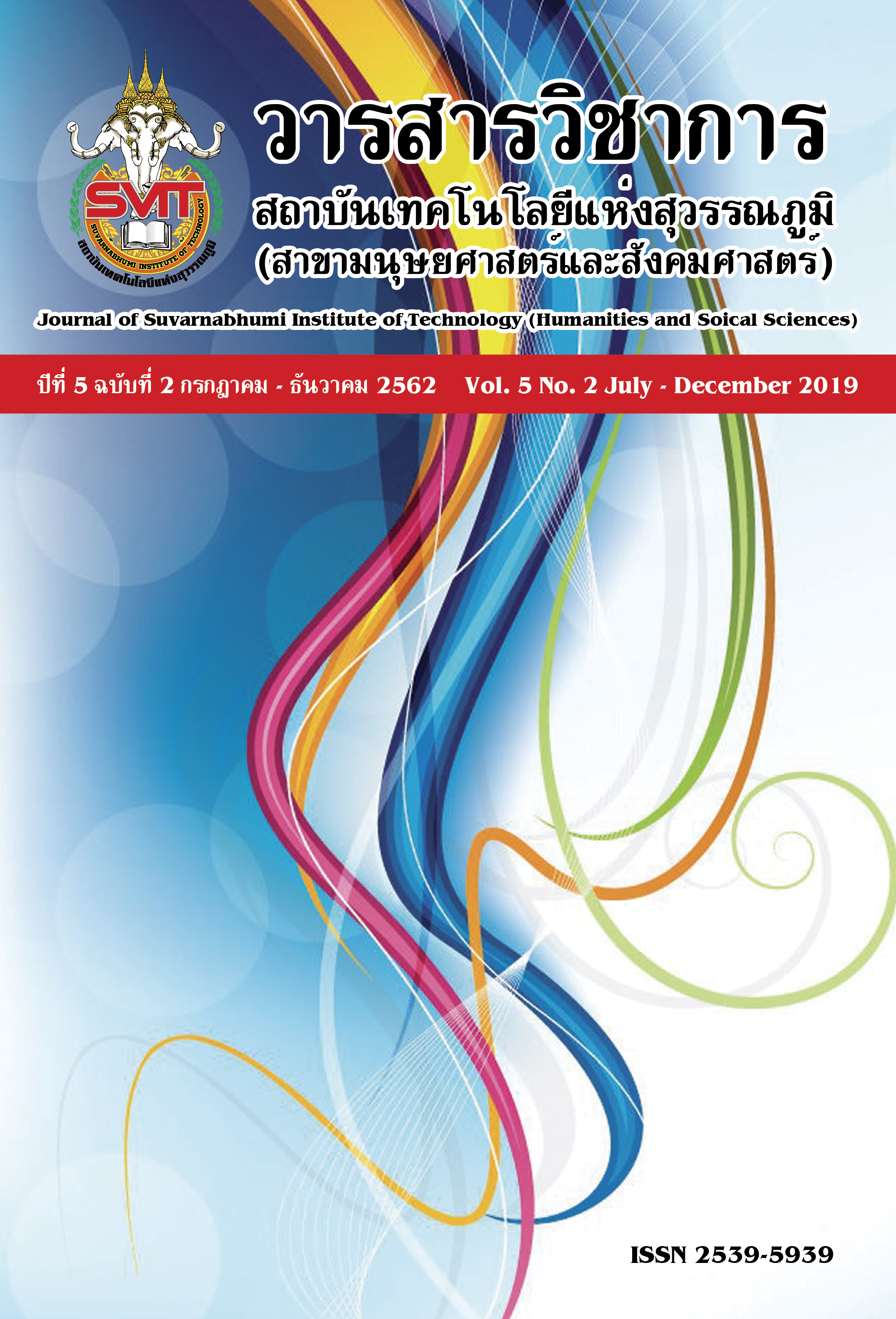A KNOWLEDGE MANAGEMENT MODEL OF EMPLOYEES IN SYSTEM INTEGRATOR BUSINESS ORGANIZATION: A CASE STUDY OF U-INDUSTRIAL TECH CO., LTD.
Keywords:
Knowledge Management Model, Knowledge Management, System Integrator Business OrganizationAbstract
Abstract
This research aims at (1) exploring the situations and problems of knowledge management (KM) and body of knowledge as required by employees of system integrator business organization: Case study of U-Industrial Tech Co., Ltd., (2) developing a KM model for employees of system integrator business organization, and (3) assessing the KM model for employees of system integrator business organization
The research procedure was consisting of 3 stages. Firstly, in an attempt to explore the situations and problems of knowledge management and body of knowledge as required by employees of system integrator business organization, semi-structured interviews were conducted with 30 executives, managers, supervisors, and employees of system integrator business organization. Secondly, to develop a KM model for employees of system integrator business organization, a 3-step Delphi technique with a questionnaire was employed with 18 experts. Lastly, 7 internal & external professionals, executives, and IT personnel were asked to assess the appropriateness of KM model, and 40 model-using employees from the sales, marketing, and IT departments were asked about their satisfaction with the usage of the developed KM model.
The research findings are as follows:
- The KM situations of employees of system integrator business organization in accordance with five processes of knowledge management are as following: (1) acquisition of beneficial job-related knowledge from Google, Website, Web page both from within and outside the organization; (2) creation of knowledge from experiences or operational expertise so that existing knowledge was added-on to be new knowledge; (3) storing and accessing to knowledge in the form of Word files, Excel, Power point, PDF, photos, or video clips, and keeping them in computers and external hard disks; (4) sharing and exchanging knowledge by using social media as a network through which everyone could share and exchange knowledge. Those social media include Facebook, Line, E-Mail, Website, Web Page, or Outlook; and (5) learning by using acquired problem-solution experiences to design/advise/improve goal-attaining work operations.
The KM problems of employees in the system integrator business organization can be grouped in accordance with the five KM processes: (1) knowledge acquisition: unavailability of information sources regarding central database of organization, (2) knowledge creation: lack of continuous training and seminars, leading thus to employees’ inability to create new knowledge, (3) knowledge storage and access: unavailability of central mechanism in data organizing, (4) knowledge sharing and exchanging: no central unit in knowledge management, and (5) learning: unavailability of data/knowledge categorization and assessment prior to using them as a strategy in organizational work operations.
The body of knowledge required by employees of the system integrator business organization in 4 departments is as following: (1) Marketing department: analytical skills regarding market problems and needs, (2) Sales department: selling technique, (3) Engineering/service department: knowledge in electronic electricity, and (4) IT/support department: skills in network server and internet.
- Development of KM model for employees in the system integrator business organization follows the five KM processes as consisting of knowledge acquisition, knowledge creation, knowledge storage and access, knowledge sharing and exchange, and learning. That includes knowledge management via website and on the internet that allows every employee to search, create, store, and exchange knowledge, as well as get learning, in which each user has his/her own user name and password together with user’s KM guideline.
- Regarding the assessment of KM model for employees in the system integrator business organization as conducted by KM experts, scholars, and executives, all of them (100%) agreed on the appropriateness of structure and components of knowledge management on website, knowledge storage and access, and learning, while 96.42% of them agreed on knowledge acquisition. Both the appropriateness of KM model and usage satisfaction were found in the highest level.
Keywords : Knowledge Management Model, Knowledge Management, System Integrator Business Organization
References
สำนักงานคณะกรรมการพัฒนาระบบราชการ และสถาบันเพิ่มผลผลิตแห่งชาติ. (2548). การจัดการความรู้จากทฤษฎีสู่การปฏิบัติ. กรุงเทพมหานคร: ผู้แต่ง.
สำนักงานคณะกรรมการพัฒนาระบบราชการ. (2553). คู่มือคำอธิบายตัวชี้วัดการพัฒนาคุณภาพการบริหารจัดการภาครัฐ ปีงบประมาณ พ.ศ. 2553. กรุงเทพมหานคร: ซีโนพับลิชวิ่ง (ประเทศไทย)
Beccerra-Fernandez, I., Gonzalez, A., & Sabherwal, R. (2004). Knowledge management: Challenges, solutions and technologies. Upper Saddle River, NJ: Prentice Hall.
Bharadwaj, A. S. (2000). A resource-based perspective on information Technology capability and firm performance: an empirical investigation, MIS Quarterly, 24(1), 69-96.
Braun, P. (2002). Digital knowledge networks: linking communities of practice with innovation, Journal of Business Strategies, 19(1), 43-52.
Construction Variety Online. (2018). (online): https://www.constructionvariety.com/16526929
Davenport, T. H. & Prusak, L. (2000). Working knowledge: How organizations manage what they know (2nd ed.). Boston: Harvard Business School Press.
Marquardt, M. J. (1996). Building the learning organization: A systems approach to quantum improvement and global success. New York: McGraw-Hill.
Polanyi, M., & Nonaka, I. (1991). The knowledge creating company. New York: Harvard Business School.
Turban, E., Mclean, E., & Wetherbe, J. (2006). Information technology for management: Transforming business in the digital economy. New York: John Wiley & Sons.
Wiig, K. (1993). Knowledge management foundations: Thinking about Thinking: How people and organizations create, Represent and Use Knowledge. Arlington, TX: Schema Press.
Downloads
Published
Issue
Section
License
บทความที่ได้รับการตีพิมพ์เป็นลิขสิทธิ์ของวารสารวิชาการ สถาบันเทคโนโลยีแห่งสุวรรณภูมิ
ข้อความที่ปรากฏในบทความแต่ละเรื่องในวารสารวิชาการเล่มนี้เป็นความคิดเห็นส่วนตัวของผู้เขียนแต่ละท่านไม่เกี่ยวข้องกับสถาบันเทคโนโลยีแห่งสุวรรณภูมิ และคณาจารย์ท่านอื่นๆในสถาบันฯ แต่อย่างใด ความรับผิดชอบองค์ประกอบทั้งหมดของบทความแต่ละเรื่องเป็นของผู้เขียนแต่ละท่าน หากมีความผิดพลาดใดๆ ผู้เขียนแต่ละท่านจะรับผิดชอบบทความของตนเองแต่ผู้เดียว





